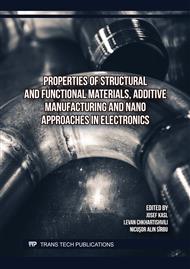[1]
R.B. Adamson, R. Pudling, Properties of zirconium alloys and their application in light water reactors (LWRs) components, in: K.L. Murty (Ed.) Materials Ageing and Degradation in Light Water Reactors – Mechanisms and Management, Woodhead Publishing Limited, Oxford, UK, 2013, pp.151-234, ISBN 978-0-85709-239-7.
DOI: 10.1533/9780857097453.2.151
Google Scholar
[2]
S.J. Zinkle, H. Tanigawa, B.D. Wirth, Radiation and thermomechanical degradation effects in reactor structural alloys. Structural Alloys for Nuclear Energy Applications, Elsevier Inc., Amsterdam, Netherlands, 2019, pp.163-209.Chapter #5.
DOI: 10.1016/b978-0-12-397046-6.00005-8
Google Scholar
[3]
K.J. Murty, S. Gollapudi, K. Ramaswamy, M.D. Mathew, I. Charit, Creep deformation of materials in lighter water reactors (LWRs)., in: K.L. Murty (Ed.) Materials Ageing and Deformation in Light Water Reactors – Mechanism and Management. Woodhead Publishing Limited, Oxford UK, 2013, pp.81-148. ISBN 978-0-85709-239-7.
DOI: 10.1533/9780857097453.1.81
Google Scholar
[4]
R. Thieurmel, et al, Contribution to the understanding of brittle fracture conditions of zirconium alloy fuel cladding tubes during LOCA transient. J.Nucl. Mater. 527 (2019) 151815. https://doi.org/10.1016/j.j nucmat.2019.1518.
DOI: 10.1016/j.jnucmat.2019.151815
Google Scholar
[5]
C. Toffolon-J.Maclet, J.C. Brachet, C. Servant, J.M. Joubert, P. Barberis, N. Dupin, P. Zeller, Contribution to thermodynamic calculations top metallurgical studies of multi-component zirconium basedalloys, J. ASTM Int. 5 (2008) 1-21. Paper ID JAI101122.
DOI: 10.1520/jai101122
Google Scholar
[6]
V. Sklenicka, K. Kucharova, P. Kral, J. Dvorak, M. Kvapilova, V. Vrtilkova, J. Krejci, Investigation of the thermal creep behaviour of non-irradiated Zr1%Nb cladding alloys between 623 and 1223 K, J. Nucl. Mater. 583 (2023) 154518.https://doi.org/10.1016/j.jnucmat. 2023.154518.
DOI: 10.1016/j.jnucmat.2023.154518
Google Scholar
[7]
M. Négyesi, J. Burda, O. Bláhová, S. Linhart, V. Vrtílková, The influence of hydrogen on oxygen distribution inside Zry-4 fuel cladding, J. Nucl. Mater. 416 (2011), 288-292.
DOI: 10.1016/j.jnucmat.2011.06.013
Google Scholar
[8]
M. Négyesi, O. Bláhová, J. Adámek, J. Siegel, A. Přibyl, V. Vrtílková, Microstructure evolution in Zr1Nb fuel cladding during high-temperature oxidation. J. Nucl. Mater 416 (2011) 298-302.
DOI: 10.1016/j.jnucmat.2011.06.015
Google Scholar
[9]
P. Kral et al., The Effect of Predeformation on Creep Strength of 9% Cr Steel. Materials 13 (2020) 5330.
DOI: 10.3390/ma13235330
Google Scholar
[10]
J. Sopoušek, M. Svobodová, Thermodynamic Prediction of Zr-Nb-O-H Phase Diagram Sections, Solid State Phenomena 172-174 (2011) 487-492. https://doi.org/10.4028/ www.scientific.net/SSP.172-174.487.
DOI: 10.4028/www.scientific.net/ssp.172-174.487
Google Scholar


